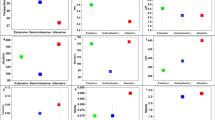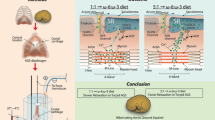Abstract
The bull’s scrotum and scrotal cord vasculature has traditionally been regarded as a thermoregulatory device for maintaining optimal testicular temperature for normal spermatogenesis. This assumption has mostly been derived from discrete measurements using thermocouples with limited data correlating continuous scrotal temperature (ST) to body temperature (BT). From mid-summer to early autumn, four Wagyu bulls (9–18 months) were surgically implanted with two data loggers (DL) logging at 30 min intervals: one on the right hand side flank and the other was attached to the visceral vaginal tunic of the mid-testis. Bulls were firstly housed in a paddock (PK) for 13 days and then moved to individual pens (IP), again for 13 days. Repeated measures analysis modelled the long-term and diurnal trends in BT and ST. While both day and time of day (TOD) were significant effects for ST at both housing locations (P < 0.005), only TOD showed significance for BT at both locations (P < 0.0001). Significant effects were seen between bulls with ST (F = 167.2, P < 0.001) but not BT (F = 0.03, P = 0.863), suggestive of variation in individual bull thermoregulatory capacity. Dual peaks were observed in ST at 0500 and 2130 h when housed in PK but not IP, suggesting ST may be influenced by external stimuli such as postural or behavioural changes. Reporting concurrent and continuous BT and ST will allow further investigation into factors influencing bovine ST and should be useful in selecting bulls with high degrees of thermoregulation capacity.




Similar content being viewed by others
References
Arendt J (1998) Melatonin and the pineal gland: influence on mammalian seasonal and circadian physiology. Rev Reprod 3(1):13–22
Brito LF, Silva AE, Barbosa RT, Kastelic JP (2004) Testicular thermoregulation in Bos indicus, crossbred and Bos taurus bulls: relationship with scrotal, testicular vascular cone and testicular morphology, and effects on semen quality and sperm production. Theriogenology 61(2–3):511–528
Casady RB, Myers RM, Legates JE (1953) The effect of exposure to high ambient temperature on spermatogenesis in the dairy bull. J Dairy Sci 36(1):14–23. doi:10.3168/jds.S0022-0302(53)91449-0
Cowles RB (1965) Hyperthermia, aspermia, mutation rates and evolution. Q Rev Biol:341–367
D'Occhio M, Suttie J (1992) The role of the pineal gland and melatonin in reproduction in male domestic ruminants. Anim Reprod Sci 30(1):135–155
Gaughan J, Mader TL, Holt S, Lisle A (2008) A new heat load index for feedlot cattle. J Anim Sci 86(1):226
Hahn G (1997) Dynamic responses of cattle to thermal heat loads. J Anim Sci 77(suppl 2):10–20
Hahn G, Mader T (1997) Heat waves in relation to thermoregulation, feeding behavior and mortality of feedlot cattle. In: Proceedings, Fifth International Livestock Environment Symposium
IPCC (2013) Summary for policymakers. In: Stocker TF, Qin D, Plattner D-K et al. (eds) Climate change 2013: the physical science basis. Contribution of Working Group 1 to the Fifth Assessment Report of the Intergovernmental Panel on Climate Change. Cambridge University Press, Cambridge, United Kingdom and New York, NY, USA,
Karabinus DS, Vogler CJ, Saacke RG, Evenson DP (1997) Chromatin structural changes in sperm after scrotal insulation of Holstein bulls. J Androl 18(5):549–555
Kastelic J, Cook R, Coulter G (1996) Contribution of the scrotum and testes to scrotal and testicular thermoregulation in bulls and rams. J Reprod and Fertil 108(1):81–85
Kastelic J, Coulter G, Cook R (1995) Scrotal surface, subcutaneous, intratesticular, and intraepididymal temperatures in bulls. Theriogenology 44(1):147–152
Kastelic JP (1999) Scrotal/testicular thermoregulation in the bull. Annual Review of Biomedical Science 1:87–101
Kastelic JP, Cook RB, Coulter GH (2000) Scrotal/testicular thermoregulation in bulls. In: Chenoweth P (ed) Topics in bull fertility. International Veterinary Information Service, Alberta, Canada, pp 16–19
Lunstra DD, Coulter GH (1997) Relationship between scrotal infrared temperature patterns and natural-mating fertility in beef bulls. J Anim Sci 75(3):767–774
McCarron H, Buffenstein R, Fanning F, Dawson T (2001) Free-ranging heart rate, body temperature and energy metabolism in eastern grey kangaroos (Macropus giganteus) and red kangaroos (Macropus rufus) in the arid regions of South East Australia. J Comp Physiol B 171(5):401–411
Moore CR, Quick WJ (1924) The scrotum as a temperature regulator for the testes. Am J Physiol--Legacy Content 68(1):70–79
Ortavant R, Bocquier F, Pelletier J, Ravault J, Thimonier J, Volland-Nail P (1988) Seasonality of reproduction in sheep and its control by photoperiod. Australian J Biol Sci 41(1):69–86
Ross A, Entwistle K (1979) The effect of scrotal insulation on spermatozoal morphology and the rates of spermatogenesis and epididymal passage of spermatozoa in the bull. Theriogenology 11(2):111–129
Sealfon AI, Zorgniotti AW (1991) A theoretical model for testis thermoregulation. In: Temperature and environmental effects on the testis. Springer, pp 123–135
Setchell BP (1998) The Parkes lecture heat and the testis. J Reprod Fertil 114(2):179–194
Setchell BP (2006) The effects of heat on the testes of mammals. Anim Reprod 3(2):81–91
Skinner J, Louw G (1966) Heat stress and spermatogenesis in Bos indicus and Bos taurus cattle. J App Physiol 21(6):1784–1790
Stanfield CL, Germann WJ (2008) Principles of human physiology, Third edn. Benjamin Cummings, San Francisco, Calif
VanDemark NL, Free MJ (1970) Temperature effects. In: Johnson AD, Gomes WR, VanDemark NL (eds) The testis, vol 3. Academic Press, New York
Vogler C, Bame J, DeJarnette J, McGilliard M, Saacke R (1993) Effects of elevated testicular temperature on morphology characteristics of ejaculated spermatozoa in the bovine. Theriogenology 40(6):1207–1219
Waites G (1962) The effect of heating the scrotum of the ram on respiration and body temperature. Exp Physiol 47(4):314–323
Wallage AL, Gaughan JD, Lisle AT, Beard L, Collins CW, Johnston SD (2017) Measurement of bovine and scrotal temperature using implanted temperature sensitive transmitters, data loggers and infrared thermography. Int J Biomet (in press)
Acknowledgements
The lead author would like to acknowledge the support received through an Australian Government Research Training Program Scholarship.
Author information
Authors and Affiliations
Corresponding author
Rights and permissions
About this article
Cite this article
Wallage, A.L., Johnston, S.D., Lisle, A.T. et al. Thermoregulation of the bovine scrotum 1: measurements of free-range animals in a paddock and pen. Int J Biometeorol 61, 1381–1387 (2017). https://doi.org/10.1007/s00484-017-1315-3
Received:
Revised:
Accepted:
Published:
Issue Date:
DOI: https://doi.org/10.1007/s00484-017-1315-3




